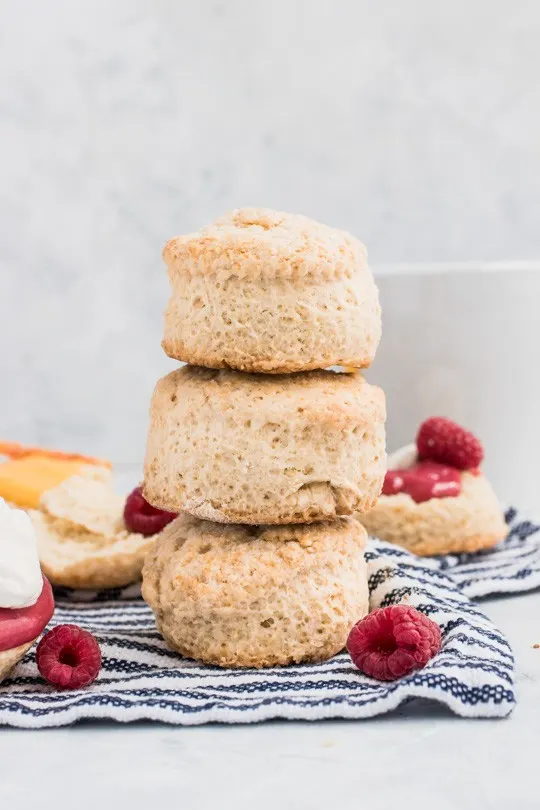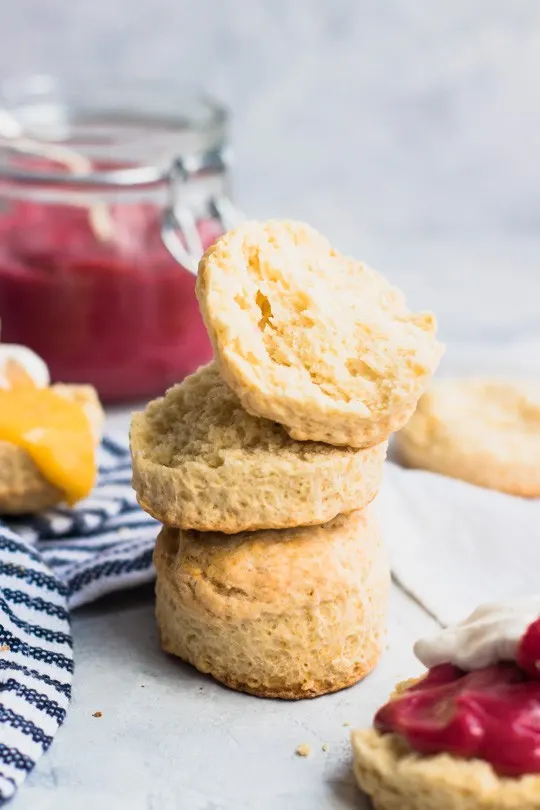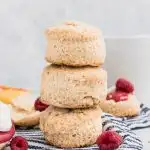This basic scone recipe is tender and soft with the slightest hint of sweetness. Top with jam, whipped cream, or lemon, orange, or raspberry curd.

Awhile ago, I bought an audiobook for Prentice. Actually, I bought several, but the one he listens to over and over is a simple story about three British children. The result has been an awful lot of old-fashioned phraseology, occasional words that haven’t been in use for over 100 years, and 10 times that many questions about what they all actually mean.
Then one afternoon, I asked him if they mentioned scones in his audiobook, and if he would .
“No, I don’t think so” he replied.
“But do they have tea?” was my next question.
“OH my goodness. YES. They have tea ALL THE TIME” he responded with appropriately dramatic hand gestures to match. Four year olds can be very expressive.
When I explained that tea was kind of like a meal, and scones were something that British children would have with their tea, he was all in on the making some. So we measured out flour, baking soda, butter and sugar. We got our hands in the mix and crumbled them together, working until the mixture felt soft between our fingers and crumbled like sand. Of course, he chattered along the whole time, telling me all about the things that happened in his book during tea time and asking why about every little thing we did.
That’s one of the things I love most about baking. The act of it can bring you together with the people you love, and the result gives you something to share with others. And these basic scones are a good place to start.
I based the recipe on one from Soulful Baker by Julie Jones, but her recipe calls for self-rising flour. Since I don’t usually keep that kind on hand, I wanted to modify it to use all-purpose flour instead. That’s why the baking powder amount may seem a little high–it’s making up for the lack of rising agent in the flour. You need all of it for a good rise and tender crumb, but not enough to add a strange flavor.
The result is something like a biscuit, but more tender and less flaky. They’re also slightly sweet, and buttery. And best of all, they’re perfect for slathering with butter or dollop of whipped cream. You can also top them with a smear of raspberry curd or a drizzle of honey. Basically, they’re a perfect, carby way to get any flavor of goodness you’d like into your mouth.




Basic Scone Recipe
- Total Time: 35 minutes
- Yield: 18–20 scones 1x
Description
This recipe for basic scones is tender and soft with the slightest hint of sweetness. Top with jam, whipped cream, or lemon, orange, or raspberry curd.
Ingredients
- 4 cups + 3 Tbsp. (500 g) all-purpose flour
- 2 Tbsp. baking powder
- 1 1/2 tsp. salt
- 1/2 cup (114 g) cold, unsalted butter, cut into small cubes
- 1/2 cup (100 grams) white sugar
- 3/4–1 cup whole milk
- whipping cream
- coarse sugar for sprinkling, optional
Instructions
Preheat your oven to 375F, then line a baking sheet with parchment paper.
Sift the flour, baking powder, and salt into a medium mixing bowl and stir well to make sure that the baking powder is evenly dispersed.
Add the cubed butter and toss it in the flour, the cut it in with a pastry blender. If you don’t have a pastry blender, you can rub it in with your fingers, working it until the mixture looks like coarse, damp sand.
After the butter is all worked in, stir in the white sugar thoroughly. Add 3/4 cup of the whole milk and stir well–the dough will still be fairly dry and crumbly. Add more milk a tablespoon at a time until all of the dry ingredients are incorporated into the dough. Stop adding milk when the dough is still shaggy, and in many different pieces rather than one large ball of dough.
Turn the dough out onto a lightly floured surface and use your hands to press it all together into one large round. Use a rolling pin to roll it out to about 3/4″ to 1″ thick, then cut it with a 2 1/2″ round cutter. Press the scraps from around the edges back together and repeat the rolling and cutting until you’ve used it all.
Place the scones on the baking sheet about 2″ apart, then brush the whipping cream on top and sprinkle with coarse sugar, if using.
Bake at 375F for about 15 min, or until the bottoms of the scones are golden brown-you can use a spatula to lift them and look underneath.
Best served the day they’re made, but these scones can also be stored in an airtight container for up to a week.
Notes
- These can also be cut into triangles by rolling the dough into a large rectangle, then using a bench knife or sharp knife to the it into squares, then triangles.
- If you feel like these are getting a bit old, just pop them in the microwave for 8-10 seconds to give them a quick refresh. Works wonders!
- Prep Time: 20 minutes
- Cook Time: 15 minutes
- Category: Pastry
- Method: Baking
- Cuisine: British

Blueberry Curd - Good Things Baking Co
Saturday 2nd of September 2023
[…] can use it in so many ways. Fill a tart, or top a scone. Or you could always top a pavlova or mini pavlovas, like in this raspberry curd […]
Orange Curd - Good Things Baking Co
Tuesday 26th of February 2019
[…] pairs perfectly with a classic scone, and I’ve also developed a recipe for raspberry curd that is pretty much it’s best […]